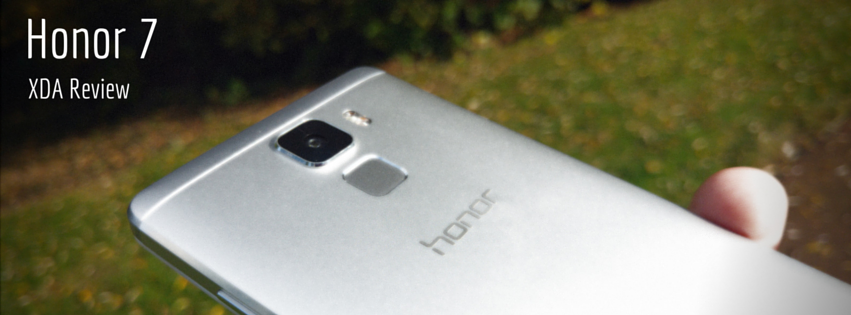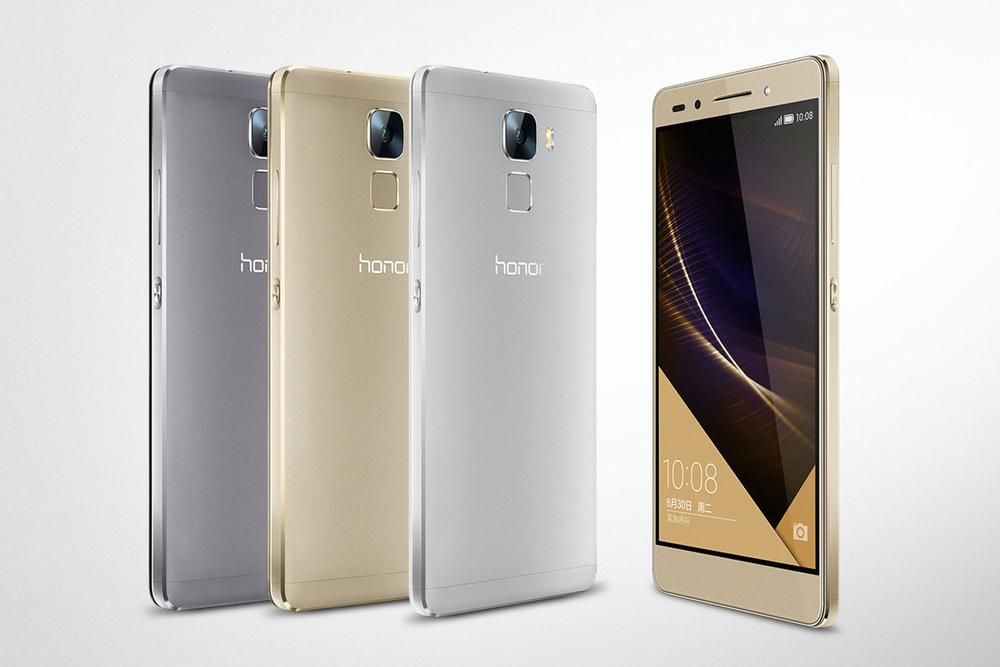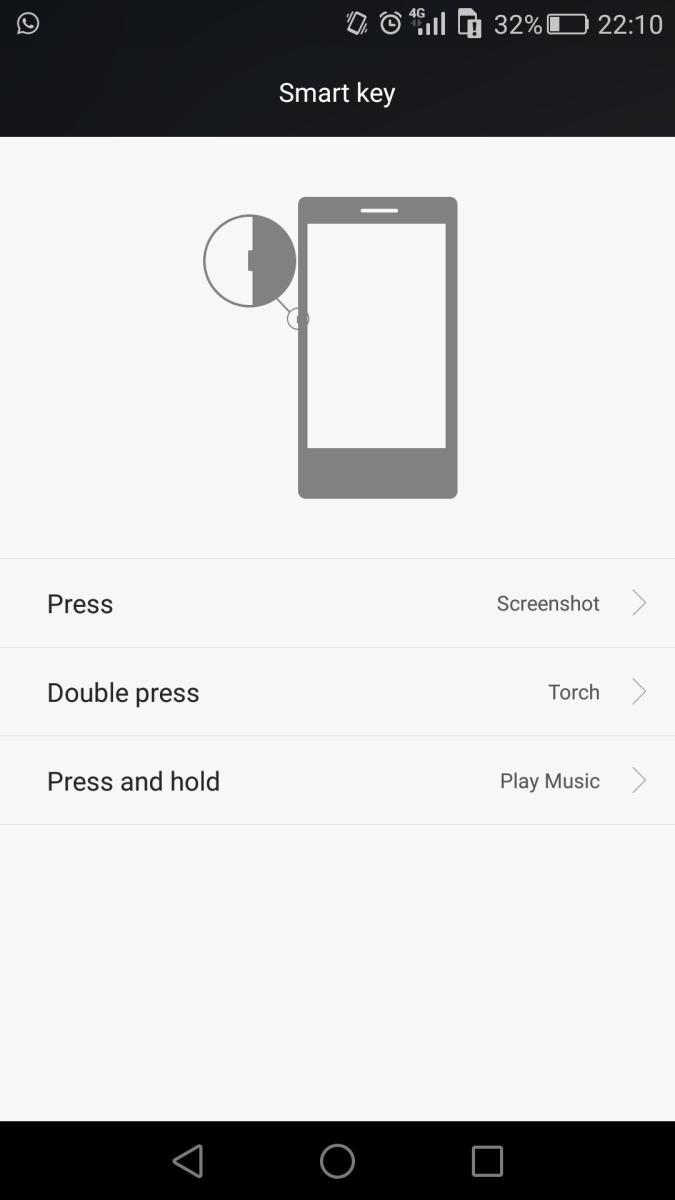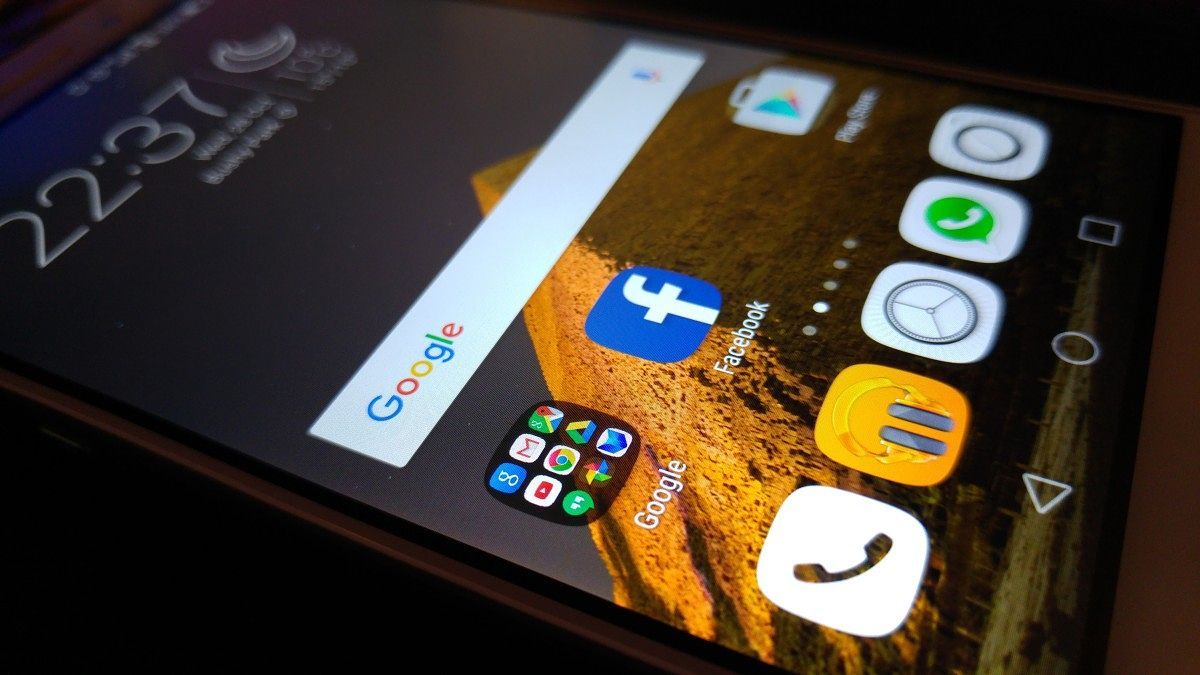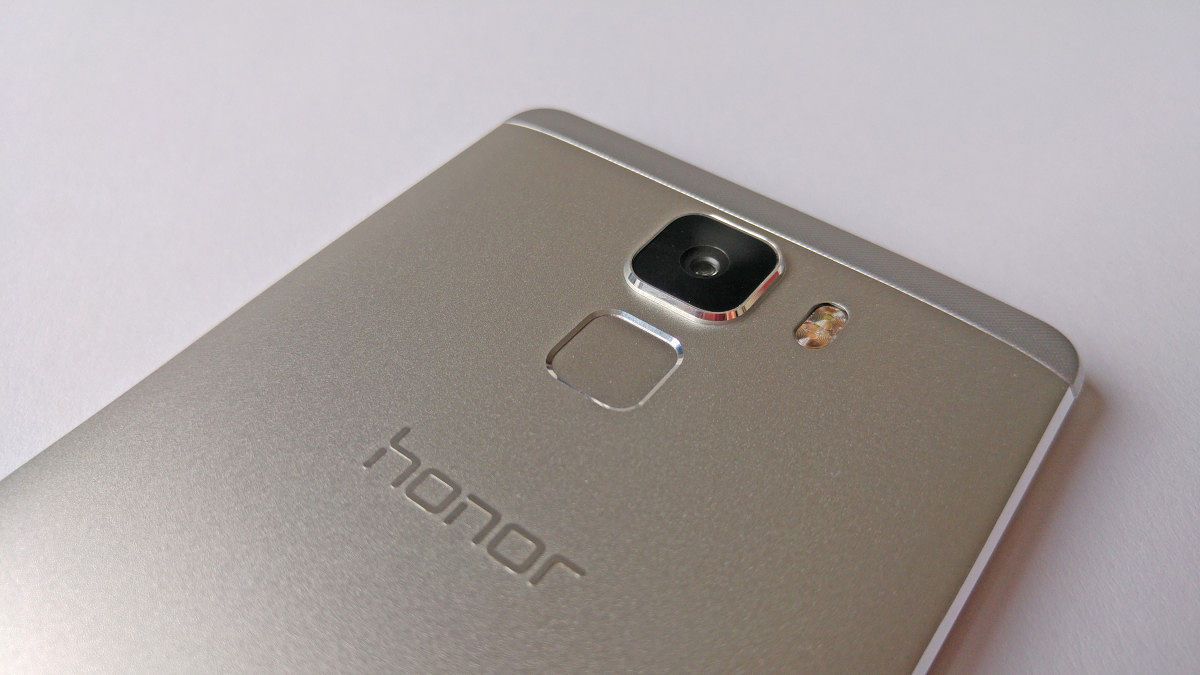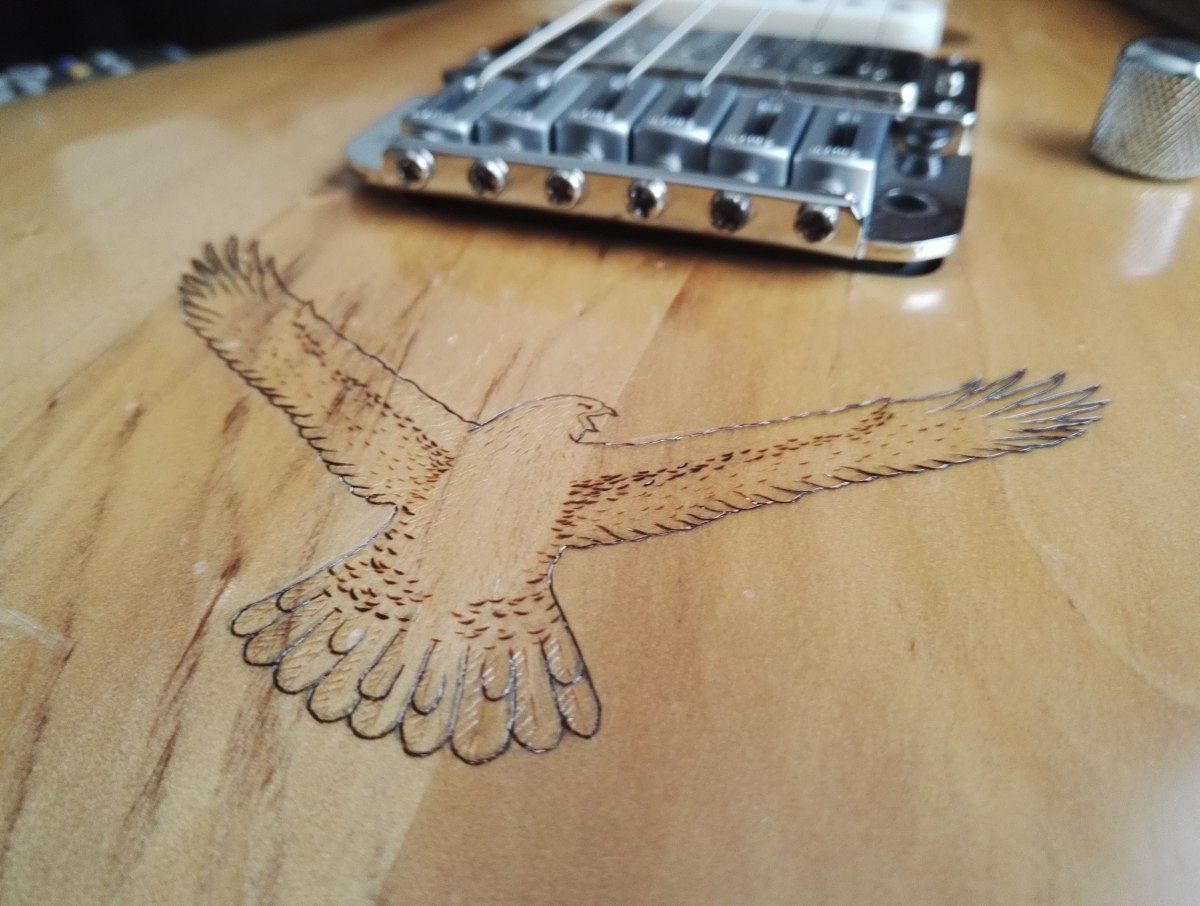Honor, for those who are unfamiliar with the brand, is essentially the European face of the Chinese giant Huawei, although it has begun selling its handsets outside this area too.
Designed as a subsidiary company that operates separately from its larger brother, its task is to try to conquer western markets with well-built phones at attractive prices.
We've managed to get our hands on its latest flagship, the Honor 7, which is available from a reasonable $370 off-contract. The device we'll be reviewing today is the PLK-L01, the unlocked European version, running the current latest version of its proprietary software, EmotionUI v3.1.
Specifications:
|
Android Version: |
5.0 Lollipop |
Model Name: |
Honor 7 (PLK-L01) |
|---|---|---|---|
|
Dimensions: |
143.2 x 71.9 x 8.5 mm (5.64 x 2.83 x 0.33 in) |
Screen size& screen ratio: |
5.2 inches (~72.4% screen-to-body ratio) |
|
Primary Camera: |
21MP, (IMX230), f/2.0 |
Secondary Camera: |
8MP, f/2.4 |
|
Screen Type & Resolution: |
IPS-NEO LCD, 1080 x 1920, 424 ppi |
Chipset: |
HiSilicon Kirin 935 |
|
Internal Storage: |
16 GB/64GB |
CPU: |
Quad-core 2.2 GHz Cortex-A53 & Quad-core 1.5 GHz Cortex-A53 |
|
Card Slot: |
Yes, up to 128GB |
GPU: |
Mali-T628 MP4 |
|
RAM: |
3GB |
Battery: |
Li-Po 3,100mAh |
|
NFC: |
No |
Features: |
Daul-SIM, Fingerprint Sensor, IR Blaster |
Design:
Huawei is generally well-regarded when it comes to the physical design of its handsets, and it stands to reason that Honor would follow suit in this department, despite aiming for a lower price-point. Thankfully it doesn't disappoint, featuring a mostly metal-clad chassis that's very reminiscent of devices like the recent Mate S, but scaled down. This is a world away from the previous all-plastic Honor 6 that came across as cheap and derivative, and shows real progression and attention from this young brand.
The rear of the phone features an aluminium body with a mostly unblemished surface, barring the fingerprint sensor and camera hump, and chamfered edges that house power and volume buttons on the right and a 'smart key' on the left (more on that later). The power button has some slight texturing to help you locate it by touch, and all of the keys mentioned have great travel, and a satisfying click. This all helps to makes the phone feel reassuringly solid in the hand, especially so for its price, whilst remaining comfortable due to the lack of sharp corners and almost imperceptibly curved rear. The only downside here is the plastic used for the top and bottom ends of the phone, which try their hardest to look like textured metal, but fail instantly when held. It makes sense that these exist, as they're probably where the antennae are held, but they jar noticeably against the otherwise premium feeling that's presented. Down at the base of the handset you'll find the speaker grilles and standard Micro-USB charging port, but as usual only one of these grilles houses a speaker, meaning mono, downward-firing audio.
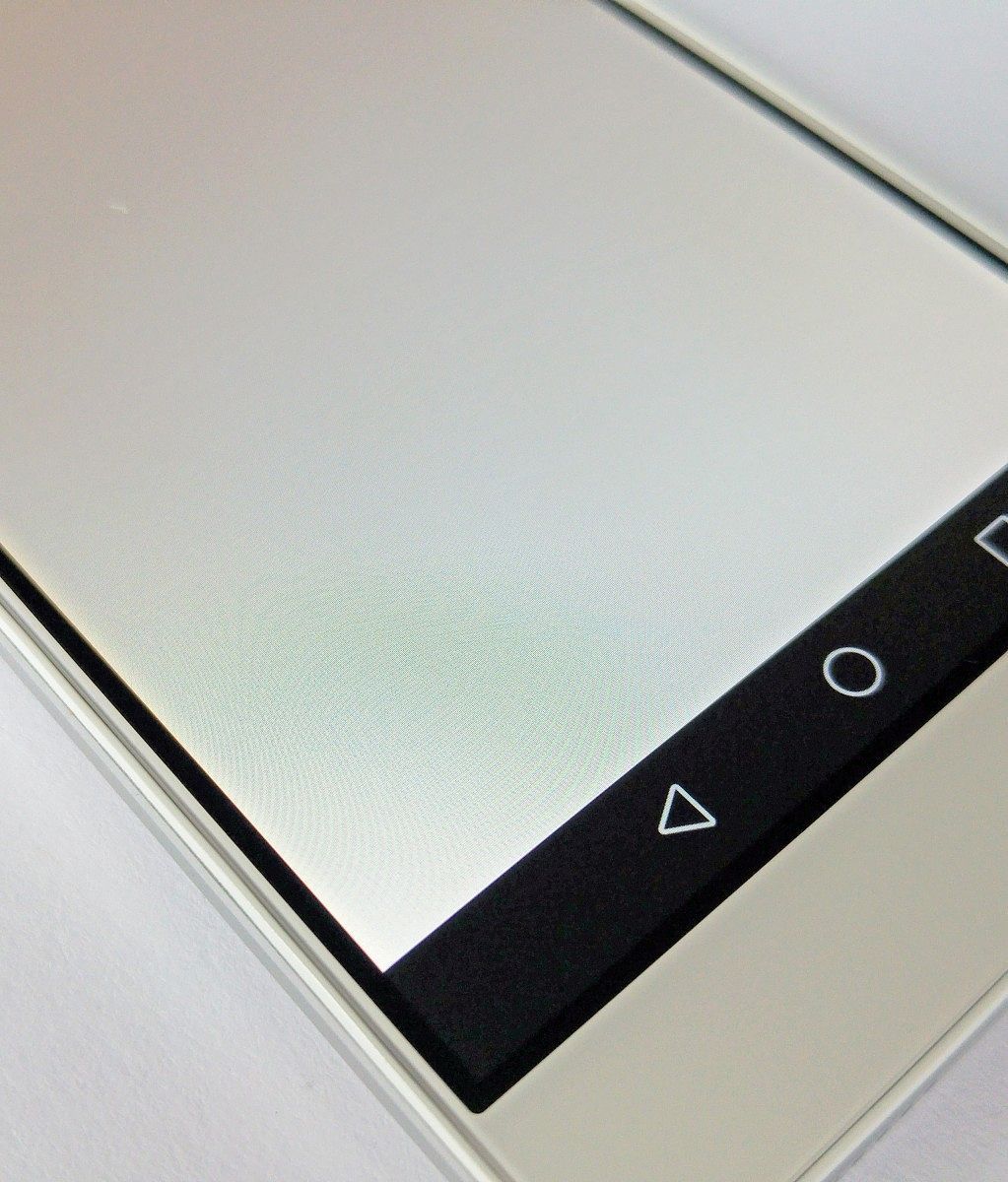 The front of the phone is is mostly nondescript, although in a pleasing way; nothing stands out negatively, it all seems ordered and simple. At the top you'll find the usual front camera and proximity sensor, along with a front-facing flash and the addition of a cunningly hidden LED notification light within the earpiece. Bezels are attractively small while the screen is off, but suffer from a second black bezel surrounding the display that detracts from the overall impression.
The front of the phone is is mostly nondescript, although in a pleasing way; nothing stands out negatively, it all seems ordered and simple. At the top you'll find the usual front camera and proximity sensor, along with a front-facing flash and the addition of a cunningly hidden LED notification light within the earpiece. Bezels are attractively small while the screen is off, but suffer from a second black bezel surrounding the display that detracts from the overall impression.
This is becoming more and more popular in smartphone design, where photos and renders of upcoming devices show almost edge-to-edge screens that ultimately don't hold up to scrutiny in reality. Personally, I'm against the bezel-less designs that circulate in the fan-render scene as it would invite frequent accidental touches along the sides of the display, but having in-set screens in this fashion is definitely not the solution.
Given the 3100mAh battery, the Honor 7 is surprisingly light in the hand, which makes a real difference when it comes to longer periods of use. Consuming media whilst travelling is one example that quickly springs to mind, where watching videos can swiftly become tiring with bigger and heavier devices. The screen size does help with this too, and is especially refreshing for anyone more used to larger-screened designs. The trade-off here of course is that you get less display area than some of the competition, but this is a very subjective area, and considering that many companies are continually stretching their smartphones out, Honor are better suited to sell to the average consumer by sticking near the 5" ballpark.
Overall, this is a pleasant phone to hold and use, with its size, depth and weight making it easy to use in one hand, and its solid build comparing favorably with phones twice its price. In this range, you won't find many phones that come close to the level of attention to detail presented here, and Honor should be happy with how their handset stands out when handled.
Performance
Huawei are known for their in-house processors, and considering the flak that Qualcomm received this year due to overheating worries, the choice of a different SOC could well be a draw for the more well-informed consumer. The Honor 7 runs on a Kirin 935, which uses two quad-core ARM A53 clusters clocked at different speeds to try to balance the contest between speed and power consumption.
This is a good chip, it must be said. Generally, the phone reacts quickly to input, with apps loading quickly and most operations performing exactly as you'd expect a well-specced modern Android phone to. However, the overall experience isn't the smoothest available. There are noticeable stutters at odd points in general use, and as much as they're over a quickly as they begin, they detract from the otherwise polished experience. A particular annoyance is the lag demonstrated when opening the Google app with a swipe up from the home button; there are several seconds of half completed animations before the app is loaded and card information is downloaded, and it happens whenever the app hasn't been used recently.
Looking at benchmarks it becomes clear that the Kirin's performance isn't up with the best of them in theoretical terms, but does have some impressive results in places. Being an octa-core chip, multi-tasking scores are generally good, but single-core tests were slightly disappointing. The device's average score of 870 puts it between the Galaxy Note 3 and s4 in terms of single-core grunt, and only 20-30 points above its predecessor, the Honor 6. Given the year that has gone by between these two phones, and the difference in clock speed and design, we were expecting a little more, regardless of the unimportance of benchmarking when it comes to every-day use. Multi-core scores are a little inconsistent in Geekbench 3, but are definitely more encouraging, placing above most of the competition, barring those handsets running one of this year's 14nm Exynos line.
There's a good reason for these unpredictable results: the GPU.
Below you can see a quick comparison with some more well-known devices that either topped the charts, along with those that scored similarly to our test phone.
It's interesting to note how the smartphone performs under pressure. Thankfully there are no issues with thermal management here, which is presumably how the Honor 7 finds itself above some high-end handsets running Qualcomm's notorious Snapdragon 810 like the HTC One M9 or aforementioned Z4. Repeated testing showed no evidence of throttling due to CPU/GPU stress, and in fact sometimes pushed the resulting scores up. The phone did warm up during heavy use, like 3D gaming or considerable multi-tasking, but not much above body-temperature which meant that it never became even remotely uncomfortable in the hand.
This chipset is backed up by a respectable 3GB of RAM, which generally keeps things ticking along nicely, although I did experience some instances of launcher re-drawing, and apps having to be reloaded from memory. This contrasted with the amount of free RAM displayed on the Recents screen, which never fell below a few hundred megabytes, even when applications were being forced to start over. This is by no means a common occurrence, and is probably caused by overly aggressive RAM management by the OS, but it makes things like a RAM-counter seem almost useless. To summarize, the whole story is one of inconsistency, and I can only attribute it to Huawei's rather heavy EmotionUI skin, as all of the above seems to show the exact same irregularities that I experienced during my normal usage of the phone, namely seemingly random slow-down marring an otherwise smooth and enjoyable experience.
Software
The Honor 7, along with its siblings and cousins in the Huawei family, uses a custom software layer called EmotionUI, that runs on top of Android Lollipop 5.0. Before you get your pitchforks out however, bear in mind that this OS is so heavily modified that there's a high chance that changes from later versions of the OS have been merged, and that the '5.0' label is just there in the name of simplicity. For example, although I haven't received any sort of update since being sent the phone a number of weeks ago, the current version of EMUI (v3.1) is vulnerable to only one of the multiple exploits for the Stagefright vulnerability. It's not perfect, but it's not simply Android 5.0 either. It is however, an extensive re-working of AOSP, making this the 'meat' of our review and what makes this smartphone individual.
Aesthetics
[paragraph_left]There seems to be one overriding theme that ties the aesthetics of EMUI together: iOS. Huawei have opted to try to ape as much of the look (and in some cases, functionality) of Apple's popular mobile OS, directly on top of Android's system design, whilst maintaining a number of Material elements for good measure. It's a combination that does admittedly create some good looking results, but also one that often can be messy, and is clearly derivative. [/paragraph_left]
There seems to be one theme that ties EMUI together: iOS
It's a mixed bag, essentially; each app when considered in a solitary fashion gives off the impression of being well thought-out, and there's an elegance in the simple nature of the designs used here. The in-built essential apps like Gallery, Videos, Calendar, and Notes work well together, being plain with a highlighted action bar that conforms to whichever in-built theme is currently in use. However, they don't function in the way normal Android applications usually do, in fact, there's a number of elements that Google encourage developers to do that just plain aren't present.
For example no there's no swiping in from the left - that gesture will simply switch between views that are available, designated by the titles shown where the Action Bar would usually be. As much as this bucks a few trends in the Android world, this might not be a bad thing at first glance, especially considering how many disagree with Hamburger Menu as a design piece, however, the idea is almost completely ruined by the inconsistency of its implementation. In many of the apps, you'll find a Hamburger-esque button at the bottom along with some other actions, which is clever, because it puts these options within easy reach of the user, but on something like the Music app, you'll conversely find the same button at top, but using a cog icon. Another example; I have to wonder why the designers of the Videos app decided to place the only button available (a Refresh button, for some unearthly reason) in the top left corner of the screen. It's not in keeping with the rest of the UI and it doesn't even match what you'll find in the Play Store. It feels as if the apps don't come from the same company, let alone the same design team, and the way that the visuals and functionality clash with the host of other Android apps that are out there means that the user will constantly be switching between styles. Again, this smacks of inconsistency, where I would trip over each jarring transition, hesitating over new button positions despite the emphasis on simplicity and large icons.
The iOS similarities continue very clearly into the Notification Panel, Launcher and most cringe-worthy of all, the Camera app. A translucent blur effect is much in evidence here which again, is a nice effect, but when used in conjunction with single-colored interface and minimalist iconography, it all becomes very familiar. The Launcher does away with the traditional app drawer, relying instead on multiple pages of apps and folders, but the Camera app really needs to be seen to be believed. When put side-by-side with an iPhone, that similarities have the potential to bring Huawei into particularly litigious territory. The shutter button is the most obvious here, using the exact same white-ringed circle present on iOS, but when you look further, the remaining buttons are all positioned in corresponding places and look entirely inspired by the designers in Cupertino. It's pretty shameless objectively and Honor and Huawei really should start again, find their own visual language and do better.
Customization
In terms of customization and control though, there's a lot to like here. The Themes app allows you to mix and match elements including wallpapers, icon packs and lock screen designs together to create a truly individual style, or download additional themes from an online store. The Launcher allows you to change grid size and home screen transition animations among a few other things, while the Quick Settings panel enables the quick re-positioning of your shortcuts, and the Navigation Bar can be rearranged and edited. Of course, many users will turn to a third-party launcher if they wish to gain more control on their day-to-day work-flow, but these kind of refinements are appreciated, and great for the more basic users who aren't aware that things like launchers and keyboards can be changed. On that note, the "Huawei Swype" keyboard that's included was actually co-developed by Nuance and Huawei, and therefore bears more than a passing resemblance to its namesake. On the whole, it's a better keyboard than you'd general find pre-installed, and includes some nifty gesture functionality, where tracing a line from a dedicated 'Swype Key' to specific letters allows shortcuts to special functions (copy, paste, etc), symbol/number layouts, and even shortcuts to apps like Google Maps.
The Settings app is where things begin to get interesting, though, giving far more customization than you'd find in AOSP. First up is some nice granular control over which applications you allow to access the internet, separated into lists of system apps and user-installed ones. This allows you to prevent applications from using data over either your mobile network or Wi-Fi, or even both, although system apps (which include the Google Apps) must always have access to Wi-Fi. This can, at the very least, allow you to make better use of your monthly data allowance your battery, and even your privacy, so that you can save sync jobs for when you're at home, or completely block apps that you don't think need network access.
This control extends to notifications too, where you can choose how each app is permitted to interact with you. You can allow notifications to be displayed on the Lock Screen, Status Bar or via the normal Lollipop banners, or any combination thereof, or you can simply choose to block notifications entirely, for those truly annoying repeat offenders. Lastly, in terms of application control, you can choose what you'd like to be able to run in the background, in order to save power and extend battery life. You'll see prompts from time-to-time suggesting apps that are consuming power silently, the frequency of which can be a little annoying, but that can be equally useful when the system points out things that you weren't aware of.
Other Features
There are a few other neat tricks that EMUI is capable of, hidden away in the settings. Firstly, always-on voice commands, that allow you to choose a phrase that can wake up your phone and perform functions similar to Moto Voice. Functions are at the moment limited to only being able to call out to your phone in order to find it if misplaced, or to place a call to someone in your address book, so unfortunately it's not currently as versatile as some alternatives.
The voice commands kept activating when they weren't needed, shouting responses from my pocket
I'm going to have to be brutally honest here once again; it doesn't really work, or rather, it didn't for me. The default phrase is 'Dear Honor', which I find a little cumbersome (especially if you're calling out to a lost handset!), and although this is apparently editable, it wouldn't accept any of my alternative suggestions. I tried a number of different phrases, over and over again in almost silent surroundings but the Honor 7 refused to allow them, complaining that I wasn't being consistent enough. Then, the phone didn't seem to pick up my commands unless I was very nearby, meaning that calling out to a phone that's potentially across a room is almost impossible, rendering the "where are you?" command essentially useless. On top of that, I found that the voice commands kept activating when they weren't needed, part way through conversations I was having, causing the smartphone to interrupt me, shouting responses from my pocket. It's a nice idea, but it's unfinished, and needless to say, I swiftly turned it off.
You also have options for Motion Controls and Gestures as seen in the screenshots above, along with double-tap-to-wake (but not sleep), and some screen-off gestures to instantly wake the phone and launch an app of your choice. None of these are anything new of course, but their inclusion is absolutely appreciated, although it must be said that the gesture recognition is rather slow to react. Huawei's knuckle recognition is also present, although it's limited to the single purpose of being able to capture parts of the screen that you circle. It's another good plan, but is a little awkward to perform and tends to capture a screenshot of the whole screen simultaneously.
There are further options available here, like being able to create a permanent floating action button that houses extra navigation bar elements, adding compatibility with smart covers, or launching apps when headphones are connected, but in the interests of brevity I'll mention only the most important remaining feature. The physical button that sits on the left-hand side of the phone is called the 'Smart Key' and can perform up to three functions, corresponding to whether it's pressed once, twice, or briefly held down. You have four choices: Torch, Ultra Snapshot (open the camera, take a picture), Voice Recording and Screenshot, or you can simply choose to launch any app. This is an excellent idea, and although not unique, it's one that should be more widely adopted.
After tinkering with it for awhile, I disabled the single-press in order to minimize in-pocket activations, tied the Torch to a double tap, and Play Music to a long press, and began to really rely on it. Considering that double-tapping the volume-down key is already assigned to opening the camera, you can really cover all the bases and I will absolutely miss this set-up on other phones.
As you can see, this is a heavy ROM. It's packed full of options and features and can be tuned quite heavily to the user's personal tastes. Unfortunately, it also comes with a fair amount of unnecessary bloatware, shown in the screenshots below. These are mostly either weblinks or demos of sponsored games, but mercifully, most can be uninstalled - the linked 'Stores' look particularly shabby, and personally I would avoid them at all cost. There are a number of 'Tools' like the 'Phone Manager' app, which either link to what's already available within the settings, or act as glorified task killers or cache cleaners. What can't be uninstalled can usually be disabled, meaning that if you want to slim down the ROM you can, but it only goes so far, and a few you'd need to root to get rid of. It should also be noted that the usual Google apps are pre-installed as system apps too, so for those that don't use things like Play Movies and TV, disabling is your only option.
All of this makes for a slightly cluttered experience, so you'll inevitably be obliged to make good use of folders. Thankfully, the system remains relatively fast, but as mentioned above, occasionally everything will stop for a time, before carrying on. As much as this doesn't happen often, it's frustrating, and when added to other oddities, it begins to annoy. No matter how many times I tell EMUI to not remind me that Google Play Music is consuming power in the background whilst I'm playing music, it refuses to take the hint. When headphones are in, you're greeted with a notification telling you that they're in (plus one for Smart Headset Control, if you have it enabled), which when cleared presents you with a warning that by doing so, you might break an app that relies on the notification. Nothing breaks, but if you want a clear notification area, get ready to do that every time. Once again, it's inconsistent and it all just feels a little premature.
Battery
Battery is a sore spot for most smartphones, and it seems that recently our own standards have lowered to the point that anything that lasts a day is generally considered good enough, but it remains a subject of the utmost importance to many XDA readers. Thankfully, in this regard the Honor 7 does deliver. It's 3,100mAh non-removable battery is of an appropriate size, and manages to adequately power the average-sized full-HD display and mid-to-high-end internals. This is a phone that will last you a day with medium to heavy usage, or into the next day if you're being conscientious. That's refreshing for me, as I tend to watch a lot of YouTube over LTE while travelling, meaning that my screen-on time is usually more demanding than a typical consumer. Additionally, I have a few email accounts push-syncing in the background, along with allowing social media and messaging apps like Facebook, Messenger and Whatsapp to run riot, and then the normal web-browsing, music listening and a few calls. This kind of usage can kill an S6 during the early afternoon, but the Honor 7 usually managed from 6:30 to roughly 20:00 before finally giving in, and as you can see from the pictures below, screen-on time was always over 4 hours, with 5 being easily within reach for those that try.
This kind of battery life is easily achieved if you care to make use of EMUI's great power-management tools. They give far more insight than other UIs do when it comes to working out what's using up your juice, and then give you ways to tackle the problem. You can view power-suckers either by looking at the percentage of power they've hogged in the normal Android fashion, or by looking at the estimated mAh that they're accountable for, and beyond that you can even compare your hardware's usage to your software's. Once you add these diagnostics to the tools that report on how much data your apps are using per day or week, the worst offenders quickly become obvious, and you can easily and accurately cut down apps that are allowed to run in the background or send data. There's also an option to apply an overall power profile, tuning the phone towards high performance, balanced, or 'Ultra' modes, the latter of which will attempt to kick-in when your battery reaches a user-definable low. This mode essentially dumbs down your phone in the same way other OEMs tend to, deactivating all wireless connectivity apart from your texts and calls. It goes one step further however, by kicking every app out of memory, and replacing the standard launcher with a cut-down, monochrome UI similar to the 'simplified home' launchers aimed at basic users. It's a powerful system, but it's also easy to use, and that's always a winning combination. I suspect not many will use it, nor use it much, but it's there for emergencies.
Hardware
The 5.2" 1080p display on the Honor 7 is a great effort, creating a crispy 424 pixels per inch along with pleasing, accurate colors. Its IPS-Neo moniker is an unusual one, being a variation on your regular LCD affair that ostensibly provides better contrast ratio and viewing angles due to its more uniform liquid crystal layer. In practice, viewing angles are admittedly very good, but contrast and black levels are not quite up to AMOLED standards. Brightness and visibility outside are on par with most panels, but again falling short of some of the best examples available today -- which isn't a detriment considering the absurd brightness of the most luminous. In general, the display is an attractive affair, and perfectly suited to viewing high-resolution images and video. The color temperature is actually adjustable from within the settings using a 'cold' to 'warm' slider, but its center position seems accurate enough for this reviewer. Some users may yearn for more pixels to suit activities like Google Cardboard applications, but at this price, cramming more pixels in would presumably come at the expense of brightness and performance.
The included fingerprint reader also comes from good stock, as Huawei have been using them for over year already, and have shown on their Mate range and the Nexus 6P how great they can be. The Honor 7's rear-mounted solution is no exception, creating minimal fuss and allowing you to quickly register up to 5 fingers. Overall, I found the reader to be very consistent, detecting my chosen fingers extremely quickly, and rejecting unknown prints just as reliably. You can unlock the phone from a screen-off status, which when combined with its natural positioning where your index finger would usually fall, makes for a very satisfying pull-from-pocket-and-use-instantly gesture - a habit which is hard to break. You can also protect your privacy by putting the phone into a 'Visitor' mode when it detects a foreign fingerprint (or PIN) that you enroll, so if a close friend of partner is used to borrowing your phone, you can still allow them access to certain parts of the OS whilst maintaining your own security.
There's one other use for the fingerprint sensor which doesn't require prints to be enrolled, and that's gesture support. By swiping or tapping any finger over the sensor, you can instruct the handset to perform a few specific functions, for example, swiping down can pull down the Notification Shade without the need for you stretching your thumb up or using your other hand. There are a few other options, like using it to take a picture or answer a call when held down, but I had to disable a couple to make sure I didn't accidentally trigger them - you can assign a single tap to be a second Back key, which can be truly maddening. On the whole, though, once you're used to it, they can become second nature, and quickly become part of your workflow.
The bottom-mounted speaker performs typically for a modern smartphone. It's not as loud as some of the recent flagship level single speakers, and certainly doesn't compete with the front-facing competition from manufacturers like HTC and Motorola. Quality also degrades once you start to approach maximum volume, with the speaker starting to break up when pushed and sounds becoming distorted. Of course, this isn't unusual at all; most phones produce pretty poor sound due to their diminutive size, but is worth mentioning for those that often rely on speakerphone calls or use their phones to amplify music. The microphone and earpiece also seem adequate enough, with no complaints from either end when it came to phone call clarity.
The main complaint in connectivity is the absence of NFC
[paragraph_right]I used the handset on the Vodafone UK network and experienced no problems with signal or 4G coverage, although the Cat.6 specification means that you won't be enjoying blisteringly fast carrier-aggregation. Most of the world should have equally few complaints, and American GSM users should be able to enjoy 3G but likely won't be able to benefit from LTE connectivity, although it's best to check the options available against the specific model number of the Honor 7 you can get hold of.[/paragraph_right]
The Daul-SIM aspect of this device is one that will be important to some consumers, although they should be aware that the second SIM slot is the only place to insert a Micro SD, and that in this case they will be presented with a persistent 'no SIM' icon in the status bar (as shown in our screenshots). Wi-Fi comes in 802.11 a/b/g/n/ac, dual-band, and Direct flavors, along with Bluetooth 4.1, and I had no issues with either. Wireless charging is not available, but 5V/2A quick-charging is. The main complaint in connectivity is the absence of NFC, however. This was a major point of discussion for the OnePlus 2 when it was released, which is somewhat of a competitor to this device, but as always it falls to the user to decide whether this is a feature that he or she depends upon.
Rooting and Android Development
Considering the audience of this website, and the fact that it's something that no other review website will cover, I decided that I had to attempt to root the Honor 7, and so reached out to Honor to ask if they minded me attempting it on my review unit. Surprisingly, they were happy for me to go ahead, on the condition that I returned it to stock before giving it back. Huawei/Honor are clearly trying to engage more with developers, and now provide a bootloader unlocking service via their website here (although I had to sign up using my phone's browser as the pages are a little buggy). Once you've entered some device-specific info you'll be given a 16-digit code which you can then use to unlock the bootloader from an ADB session in the normal fashion - see this thread for further details. This manufacturer-supported unlocking process is becoming more and more common between OEMs, and Huawei should be applauded for joining the ranks of dev-friendly companies.
Unfortunately, it gets a little grim from here on in. Once bootloader-unlocked, it's simple to push a recovery from ADB, but I had to flash twice before it would boot into TWRP, which turned out to be a Chinese version, and so less than ideal. Then I found that there was no way to boot back to system; I was stuck in a bootloop of sorts, where only the new recovery would load. After eventually finding a stock recovery I managed to flash that instead of TWRP, and boot back into the system. It turns out that at the moment, to flash something like SuperSU or Xposed, you have to push TWRP from ADB, flash your files from TWRP, then reboot and flash stock recovery, then boot back into system.
At this point I decided to quit while I was ahead, for fear of making a wrong-turn and then spending hours attempting to return the phone back to a bootable state - something with which I'm sure many of our readers can identify. It's a little early for custom ROMs at the moment, clearly, although there are those on the forums who have managed this process successfully, despite the many differing versions of the phone being available. Once this is solid though, and begins to work for everyone, you can expect de-bloated EMUI and MIUI ROMs to be created, along with unofficial CyanogenMod builds and customs like LiquidSmooth if the Honor 6 forums are anything to go by.
Camera
On the raised hump at the rear of the Honor 7 you'll find a 21MP Sony Exmor RS sensor, specifically the IMX230, the same module found on Motorola's 2015 flagships. It also suffers from the same handicaps, like the lack of OIS and the fairly small 1.12μm² pixels, and so you'd expect any differences to be the result of differing software approaches. But on this subject, Huawei has chosen a fairly unique path, by foregoing the use of a dedicated image-processing chip like all of the competition, and shunting that workload over to the Mali GPU. By using the OpenCL API, which is designed to manage workload over heterogeneous systems, the Chinese manufacturer has cleverly given itself a way to upgrade the image processing later in the phone's lifetime, where other OEMs will permanently be stuck with a hardware solution that is un-modifiable. So, with the following, it's important to bear in mind that future software updates could affect this unit's performance quite significantly.
Pictures taken with the Honor 7 generally retain a lot of detail thanks to the high megapixel-count, which means that those shot in good light and close to their target can look very good. This is aided by what looks like quite a high emphasis on boosting contrast, which can sometimes give the impression of looking highly accurate, but at other times can really ruin the dynamic range of an image, pushing blacks and whites to their very extremes. This becomes more interesting when you consider how washed-out colors can look, even in good light, considering that there's clearly a lot of image processing going on. That said, although noise reduction is clearly in evidence, it's not overdone, and therefore you don't tend to get the 'brush stroke' look that some cameras are guilty of. White-balance is on the money most of the time, but the cold color palette does have an effect on this, and depth of field from the f/2.0 aperture can look very pretty.
This is a camera that especially benefits from steady hands, or a tri-pod. Presumably due to the lack of OIS (or longer exposure time to counteract the sensor's lack of light gathering), some of my outdoor pictures taken naturally blurred multiple times, even though conditions were sunny (for the UK). Low-light shots are actually not bad, doing a decent job of maintaining white balance and color accuracy despite the higher noise. Of course, cameras can be subjective, so take a look at the shots featured below keeping in mind some of the overcast or under-lit scenarios. You'll also see a few comparisons with an LG G4, which generally takes more pleasing and saturated pictures, but do bear in mind that we're comparing a new-to-the-market $370 phone with one that's now dropped to roughly $420.
The camera app itself is well laid out and easy to use (thanks to Apple), and has a variety of shooting modes. Your initial options are Photo, Video, Light painting, Beauty, and Good food (I know, I know), which you can swipe between quickly, with buttons for the flash, filters and gallery also in easy view. For the remaining options which include HDR mode, Panorama, Time-Lapse and a few others, you'll need to select a different mode via an overflow button.There's no Pro mode like you'd find on the recent Huawei Mate S, and no RAW capture of course, so these inbuilt modes have to be completely replied upon.
Ultimately it's quite a powerful range, suiting almost every situation, and one that allows you to be pretty creative whilst at the same time coming across as simple for those that want to point-and-shoot. And that clearly is the aim of this camera; any and all advanced options are hidden two to three menus deep, including essentials like white-balance and exposure, meaning that you have to leave the menu every time you make a change to actually see the effect that it's had. Highlights include the Super Night mode, that takes a 15 second exposure whilst attempting to remove any moving obstacles from the resulting picture, and All Focus, which takes a burst shot and allows you to choose a focal point later, and both of these can have very effective results if the device is held still. Video quality is passable, demonstrating the same lack-lustre colors featured in the photos, but exposure and focus adjustments are quick, and the digital stabilization and object tracking can really help you keep hold of a target and make sure the moment isn't lost.
On the whole, it's a decent effort and is quite justified by the price, being capable of producing some very nice shots in the right environments. However, it's clearly a 'capture the moment' camera, and so enthusiasts will probably want to fork out more money elsewhere to gain some added control and accuracy, for now at least.
Verdict
It's difficult to work out exactly where the Honor 7 falls in terms of class. On the one hand, you have a solid build that feels great to use, backed up by a pretty screen, decent camera and good overall performance. On the other, you have a UI that can be clumsy and that feels like it's just out of beta, a few stutters in performance and the fact that nothing about the phone blows you away. When you compare that with the price, it starts making a little more sense - this is a good phone, no question about it, but it's not designed for those who take their smartphones seriously.
This is an Android phone designed to appeal to an iPhone user who wants to save some money on their next upgrade. It does almost everything pretty well, or well enough to get by, but it never excels. However, the UI is simplistic, and it's similar enough to iOS that platform-switchers won't get as confused as many seem to, when given something like an LG or Samsung. What's more, there are some innovative ideas displayed here, some that you won't find anywhere else, that are genuinely useful, and that I will miss when I move on. So actually, it could simply be a question of timing: Is now the right time to buy an Honor 7?
This reviewer doesn't think so. Given that a few software updates could improve the consistency and fluidity of the software experience, and improve the camera, and that Huawei have promised a Marshmallow update for this phone, good things could easily come to those that wait. The same works in parallel when you look at the price and that's the important point; if Honor can make this more easily available (and compatible) in the US, and can cut the price a little over the coming months, this device would start to look far more compelling. It beats budget handsets like the Moto G in things like build and camera quality, but undercuts the big names at the top, whilst staying attractive to a lucrative middle market of consumers that want an easy life. Honor have found their target, and have aimed right at the bulls-eye, they just haven't quite worked out how to fire yet.
What do you think of the Honor 7? Let us know in the comments!

